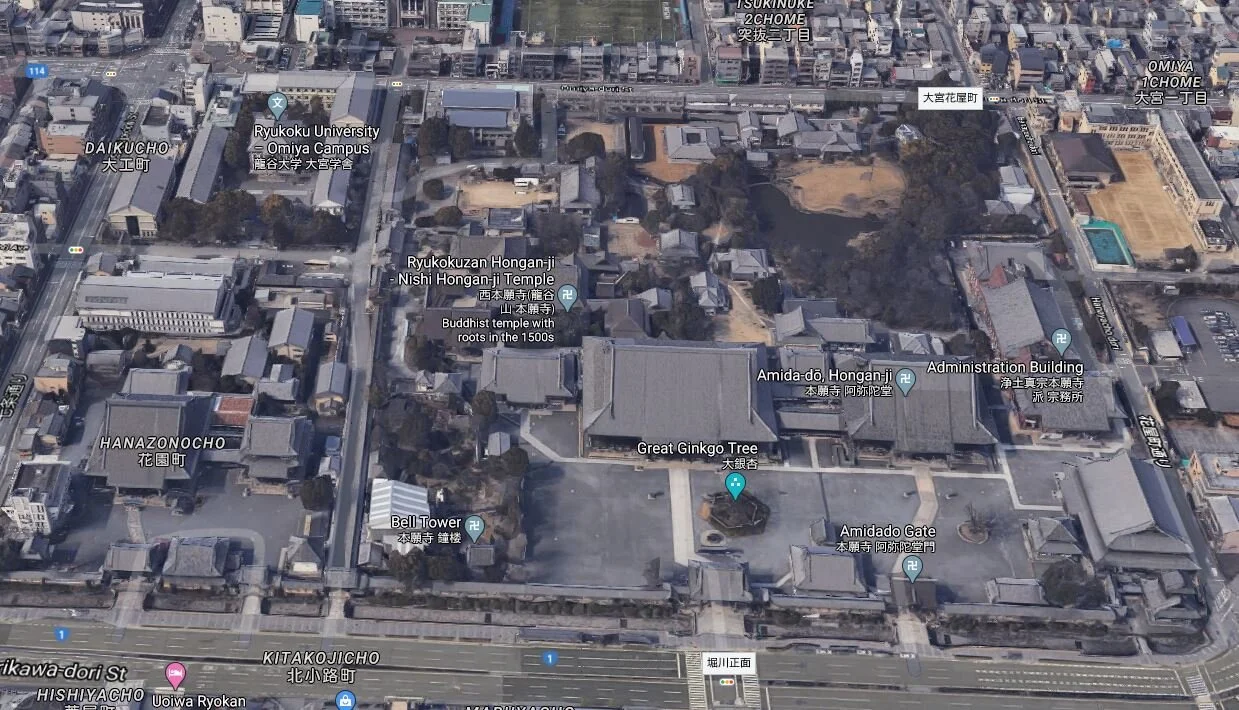Introduction to Jodo Shinshu Buddhist Practice by the Temple President
At our Salinas temple, we practice a form of Buddhism called Jodo Shinshu, which is part of Pure Land Buddhism practiced in many parts of Asia. Pure Land is a tradition of Buddhist teachings that are focused on Amitābha Buddha. To us, it is Amida Buddha. It is part of a Mahāyāna Buddhism tradition practiced in China, Japan, Korea, and Vietnam. Other Buddhism branches are Theravada which is practiced in Sri Lanka, Thailand, Cambodia, Burma, and Laos, and Vajrayana (also called Tantric) is closely associated with Tibetan Buddhism. It also exists in smaller numbers in China and Japan. A more detailed explanation of Jodo Shinshu practice and its history is explained in the links below this page.
The Buddhist Temple of Salinas was established in 1924 by Japanese immigrants that had moved to Salinas to work in the farms much earlier. Many had started small shops and owned their farms by the time the temple was built. You can read about the history of our temple on this website. Our temple is part of an extensive network of other temples in the U.S., and it is organized under Buddhist Churches of America (BCA), with 60 temples or associations spread across the nation. The largest concentration is on the West Coast. The head temple for our sect is located in Kyoto, Japan, called Nishi Hongwanji Temple.
Nishi Hongwanji Temple in Kyoto, Japan.
Amidado in the foreground, and Goeido in the back. Goeido is dedicated to Shinran, the founder of our sect. It is the largest wooden structure in Kyoto. Amidado enshrines Amida Buddha, and it is almost as large as Goeido. Goeido was rebuilt in 1636, and Amidado in 1760.
image by 663highland, licensed under CC BY 2.5
Arial view of Nishi-Hongwanji temple complex in Kyoto, Japan. Many buildings and items within are National Treasures of Japan. It is also a World Heritage Site. The compound was established in 1591. Previously, the sect occupied the land where Osaka Castle now stands. Next to the Nishi Hongwanji compound to the left is Omiya Campus of Ryukoku University, which is associated with the sect. It was founded in 1693 to train Buddhist priests and became a secularized institution in 1876.
Google Map
We are the largest Buddhist sect in Japan, with estimated 7 million followers, and there are over 10,000 temples located throughout Japan. Our sect also has the largest reach of any Buddhist sect globally, with a large following in Hawaii with 30 temples, in Canada with 13 temples, and in South America with 35 temples. There are also other temples in Taiwan, Australia, Mexico, and Nepal. Altogether, there are over 200 Jodo Shinshu temples outside of Japan. In the U.S., our headquarters is located in San Francisco, and our ministerial training and education center is the Jodo Shinshu Center, located in Berkeley, CA. This center is also affiliated with UC Berkeley, offering courses in Buddhism to the students there. A correspondence course in Jodo Shinshu teaching is also provided through our Jodo Shinshu International Office (JSIO) located within the headquarters building in San Francisco.
Jodo Shinshu Center in Berkeley, CA
The founder of our sect is Shinran (1173-1263). The year 1224 is considered the establishment year of our sect when Shinran wrote the magnum opus of his career called Kyōgyōshinshō, which serves as the basis of our practice.
Portrait of Shinran
Our Jodo Shinshu teaching is deceptively simple, but it is elegant and carries great power to deal with all the ups and downs of life. It teaches us how to live, appreciate what we have, and live our lives to the fullest each day. We recite the Nembutsu, which is composed of a simple phrase, "namoamidabutsu" which is based on Pali words used in India at Shakyamuni Buddha's time, and it means, "I take refuge in Amida Buddha." It is also an expression of gratitude. It is to say thank you to Amida Buddha for guiding us to salvation. Thirdly, Amida Buddha's name is an invocation that Amida Buddha has fulfilled his "Primal Vow" of saving every sentient being in the universe. We also chant the "Okyo" which means teachings in Japanese, during our services. Okyo's are scriptures that were written in Chinese script. It has been passed down to us for many centuries, and these, in turn, were translated from the original scriptures that were first written down in the Pali language in India around the first century B.C. This was many centuries after Shakyamuni Buddha's death. Today's chanting can be considered a form of meditation, as it is done in a musical and rhythmic manner. Our chanting is not so different from Latin chants that the Roman Catholics used until relatively recently. Today, very few can read the Chinese script and understand what it means anymore, but this is ok; we have good translations.
So the question is, why did Jodo Shinshu Buddhism became so popular in Japan and stayed this way for so long over many centuries? It is the dominant form of Buddhism that is practiced in Japan, and our immigrant forefathers brought it with them when they arrived in America. At various periods in Japanese history, the Jodo Shinshu practice gained so many followers that the ruling class attempted to suppress it. Shinran himself was exiled for many years in Northern Japan for his ideas. During the Sengoku warring nations period in Japan (1467 to 1615), the feudal lords began to fear the Jodo Shinshu sect's political power. They attempted to suppress the religion by brutal and ruthless means, but they failed. The ultimate winners of the Sengoku period were Toyotomi Hideyoshi and Tokugawa Ieyasu. They came to accept the sect, and a long period of stability followed. However, in some parts of Japan, especially in Kyushu Island, Jodo Shinshu continued to be suppressed until the end of the feudal era in 1868. The Meiji Restoration brought a revival of Jodo Shinshu practice in Kyushu and quickly became dominant. Shortly afterward, Jodo Shinshu missionaries followed the Issei immigrants to America, Canada, and South America and established many new temples.
Our forefathers who came to the U.S. faced numerous hardships, discrimination, and what life often brings in suffering and tragedies. When World War II started, the Buddhist ministers at all the temples were the first ones that were arrested and put into prisons and kept separate from the congregations and their own families. They were treated as agents of a foreign government, as spies and subversives, intent on destroying the American way of life. All Japanese were rounded up and sent to relocation camps with short notice, and most people lost everything they possessed. After the War, they had to start their lives again, facing severe discrimination in many places they had returned. The situation was exceedingly terrible in Salinas. Their Jodo Shinshu viewpoint of life helped them persevere, carry on with their lives, and make them strong.
One of the critical reasons why Jodo Shinshu was so popular and could not be wiped out was because our practice is straightforward to understand, and it does not discriminate. It does not matter who you are, what your past is, and what class you might belong to. The reason is that Amida Buddha does not discriminate. Amida Buddha accepts you as you are and leads you to salvation, without exception. Today's society is increasingly becoming stratified and divided along wealth, political, religious, racial, sexual orientation, and gender lines. Unfortunately, many religious groups are only too happy to amplify the divisions if it serves their religious viewpoints. Our Jodo Shinshu teaching is very democratic at its core, and everyone is treated the same. This equality is what Shakyamuni Buddha also preached, and it is also central to Jodo Shinshu's teaching. It was one reason why the feudal lords of the past wanted to suppress it, as it went against the stratified society that they needed to control the population.
According to Buddhist teaching, we all suffer from blind delusions that cause us to want, covet, have ill-feelings toward others, and thinking about "self" all the time without understanding what "self" is all about. In Pure Land Buddhism, to escape this fundamental nature of our "self," all you have to do is entrust yourself to Amida Buddha. The Nembutsu is an invocation that leads us out of this delusion of "self."
In our Jodo Shinshu teaching, we do not have rules, commandments that we must follow, and there is no us and them, believers vs. non-believers. We are all suffering from the same problems and delusions; therefore, we are all equal. If this idea sounds intriguing, then perhaps you should read on and find out a little more about our Jodo Shinshu teaching. But you have to look a little deeper than just the surface, with our practice of chanting and reciting our Nembutsu, which might appear non-sensical and strange at first. Beneath it, you will find the reason why Jodo Shinshu has endured for so many centuries and brought meaning to the lives of its followers.
March 9, 2021
Tom Yamashita
President, Buddhist Temple of Salinas




